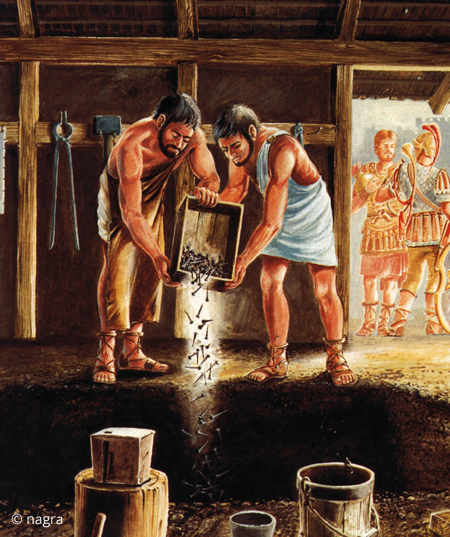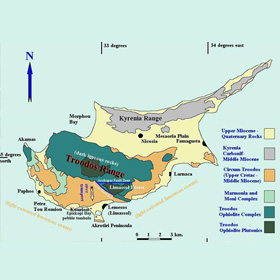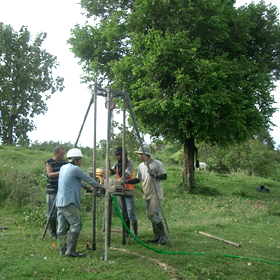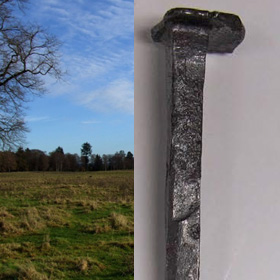Introduction
Traces of the future video
Argumentation by use of analogy is well established in many fields including philosophy, biology, linguistics and law, and most scientists are familiar with this approach and will have used it at some point in their career. For example, in the oil industry, accessible (surface) analogues of the geological conditions expected in physically inaccessible deep oil and gas reservoirs are often studied. Reservoir models of the fields lying deep beneath the North Sea, for example, were built almost exclusively on the results of study of the faulted sandstones of the Sinai Desert and Utah, USA.
For the specific case of radioactive waste disposal, the main inaccessible features are:
- the very long time it will take for long lived waste to decay to safe levels – how can anyone know how the materials which are used to contain the wastes will behave over thousands to millions of years?
- the large spatial scales which cannot be directly addressed in a laboratory – how can the migration of radionuclides through several hundred metres of host rock from the repository to the earth’s surface be studied and modelled?
- the heterogeneity and structural complexity of the geological environment which will host the repository – how can this ever be approached in a laboratory or modelled on a computer?
Hence the study of natural (predominantly geological) systems has been termed natural analogue research within the radioactive waste disposal community and the term “natural analogue” (NA) has developed a particular meaning associated with providing supporting arguments for a repository safety case (see the NA overview folder in the library page). As noted above, the key factors here are the heterogeneity and complexity of natural systems and, in particular, the very large dimensions and long timescales over which safety must be assured.
Due to the long timescales of concern, the basis of most safety cases is a quantitative evaluation that is based on complex mathematical models and their general lack of transparency only adds to the mistrust of many stakeholders. How then can people be convinced that it is possible to assess the performance (and thus ensure the safety) of a repository over the long timescales of interest? One way is to address the robustness of the safety assessment models, by clearly indicating the form and extent of model testing carried out within the repository safety assessment. Not only can this show that the individual component parts of the complex structure which constitutes most safety assessment models have been checked, but also that the 'mathematical black boxes' constitute an acceptable representation of the repository system.
Part of the problem undoubtedly lies in the unusual nature of radioactive waste disposal: in most major engineering projects, such as bridge construction or aerospace engineering, the designs are tested against a range of laboratory experiments backed up by expert judgement based on experience with the same or similar systems. Here repository design deviates from standard engineering practice in that only a few repositories currently exist and testing their compliance to design limits will be impossible due to the timescales involved. In addition, peoples’ anxiety about most things radioactive means that they require some greater form of 'proof' that a repository is safe than they are willing to accept for other engineered systems. This being the case, significant additional effort has been expended within the radioactive waste disposal community to make it clear that the safety assessment models can adequately predict the long-term behaviour of a repository.
What are natural analogues (NA)?
Traditionally, safety assessment modellers have placed much weight on laboratory data for the construction and testing of their safety assessment models and, with only a few exceptions, have not integrated in their safety assessments data from either NAs or in situ experiments in URLs (Underground Rock Laboratories). The over-dependence on laboratory data is understandable in that the information is produced under well understood, fully controlled conditions and thus the modellers feel they can place a high degree of confidence in the results obtained.
Unfortunately, the full complexity of a repository cannot be re-created in a laboratory and it is necessary to address processes which are influenced by natural heterogeneities, which include large degrees of uncertainty and which operate over very long timescales. In this case, it is necessary to supplement laboratory data with information from in situ URL experiments and NAs.
The potential evolution of geological repositories can be simulated by the use of mathematical models, but the extent to which such models can be validated by conventional approaches is inherently limited. Here natural (along with archaeological and anthropogenic) analogues – systems which have similar properties to components of repositories – have an unique role to play. Arguably, the extent to which natural system evolution in the past can be understood and modelled with existing tools and data, also gives an indication of the ability to determine the future development of a repository.
How do we use natural analogues (NA)?
In its basic form, a NA study can be any type of investigation of any relevant natural system, as long as it provides quantitative or qualitative information which can be used to support (and build confidence in) geological disposal. This may mean that a study provides data which are directly applicable to the safety case or, alternatively, it may provide illustrations of concepts or processes which can demonstrate safety. Each repository design will require unique information to assist in building and presenting the safety case but, historically, NA studies have tended to focus on only a narrow range of natural systems. They can thus be categorised into a few broad groups which are representative of some major components of a repository system or feature of its evolution, namely:
- natural geological and geochemical systems
- archaeological systems
- sites of anthropogenic contamination
It should be noted, however, that this focus is currently changing and examples of a more broad-based approach to the use of NA in supporting the safety case are available in the NA overview folder in the library page. Nevertheless, the objective of the following short discussion is to describe the features of typical NA systems and to discuss some of their limitations.

Roman nails buried in Scotland have been used to assess the longevity of steel containers for HLW
A range of geological and geochemical systems may be investigated as NAs, provided they are appropriate to the repository system of interest. Historically, the natural systems that attracted the most interest were uranium ore bodies (e.g. Ruprechtov, Czech Republic – see the radionuclide migration studies folder in the library), naturally occurring high-pH systems (e.g. Maqarin, Jordan – see the cementitious materials folder in the library) and naturally occurring metals, glasses and bitumens (examples in the library). Taking uranium ore bodies as an example, primary and secondary concentrations of uranium occur in many different geological environments. Their principal interest as a NA lies in the mechanisms which have been responsible for their original deposition and any subsequent remobilisation of the uranium as they are analogous to those which might be expected to occur in and around a HLW (high-level waste) or SF (spent fuel) repository. Secondary deposits and areas of uranium remobilisation adjacent to ore bodies are also of interest because they usually form at temperatures which are representative of conditions in a repository (i.e. < 100ºC).
One limitation of ore bodies is that many are at relatively shallow depths (e.g. pdf Oklo(1.40 MB) , Gabon - from the NA Overviews/Analogue Reviews/Analogue Reviews section of the library), where high fluxes of groundwaters, especially oxygenated groundwaters, will dominate both the current and recent transport processes. This means that extrapolation to the low-flux, chemically reducing conditions expected in a repository requires very careful characterisation of the site palaeohydrochemistry. This can be difficult as significant extrapolation from measured data is required and depends on estimation of often unknown boundary conditions (such as the initiation of recent groundwater flow through the ore). In addition, ore bodies which have been actively mined (e.g. Poços de Caldas, Brazil) may be so perturbed that it becomes difficult to define the original natural boundary conditions.
Overall, then, the main features of uranium ore bodies of potential relevance as a NA are as follows:
- the composition, long-term stability and corrosion/dissolution behaviour of uraninite as an analogue to spent fuel
- the role of redox processes in mobilising and retarding radionuclides, including redox fronts and other geochemical discontinuities, as an analogue of the conditions around a steel waste container
- the speciation and solubility controls of radionuclides in groundwaters (including colloid formation) as an analogue of the behaviour of radionuclides in the EBS (engineered barrier system) and host rock
- the downstream retardation processes affecting remobilised radionuclides, including sorption phenomena on various surfaces and diffusion into the rock matrix porosity as an analogue of the behaviour of radionuclides in the repository host rock
- the ability to use natural decay series disequilibria to estimate the longevity of various mobilisation and deposition processes as an analogue of the processes expected in the EBS and repository host rock
A short overview of some completed/ongoing NA studies is provided in the paper here: pdf Alexander et al 2015 NA review for SJG(4.51 MB)




